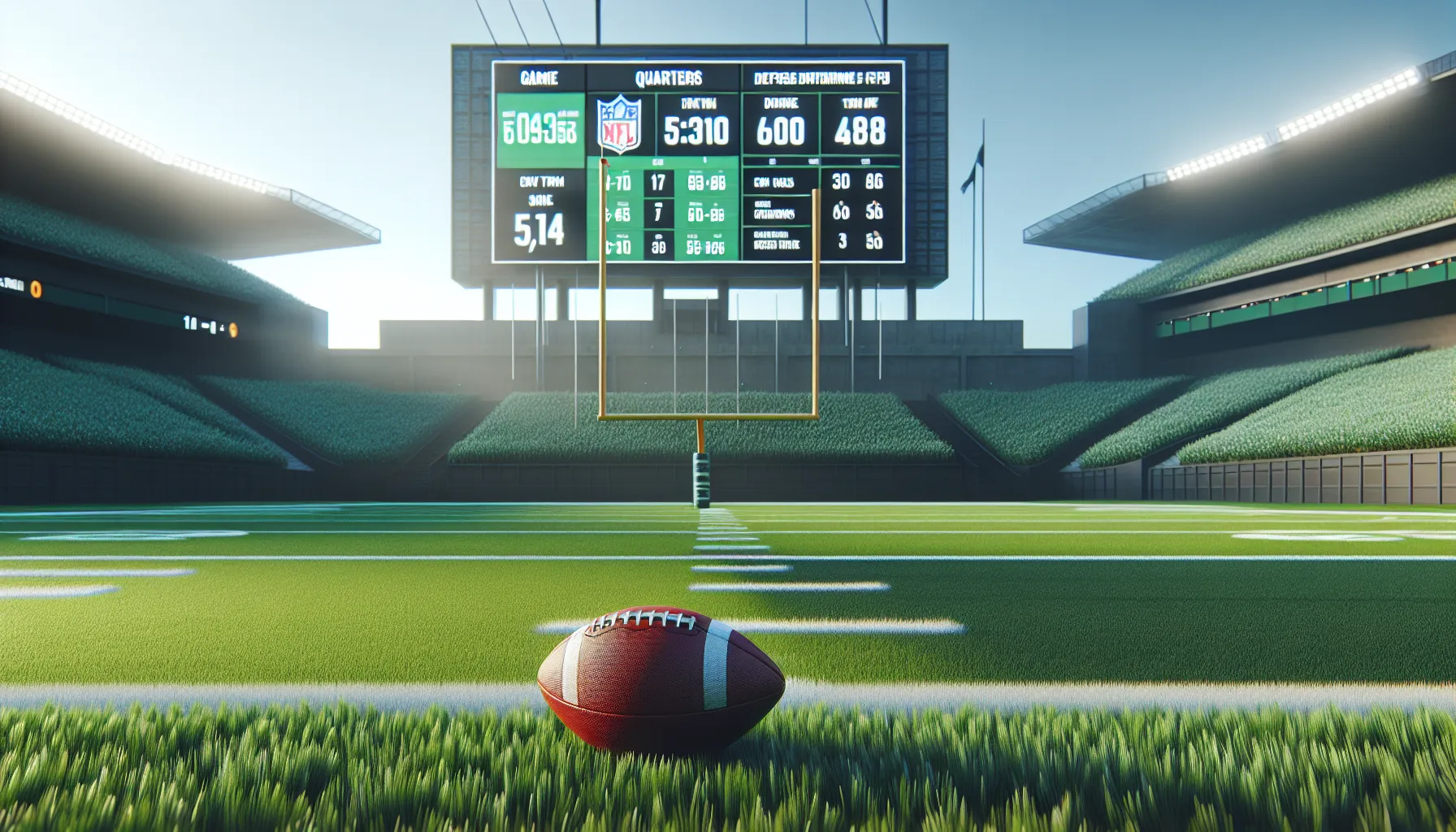Key Takeaways
- NFL quarters last 15 minutes of game time, but frequent clock stoppages and breaks extend their real-world duration.
- A complete NFL game consists of four quarters, totaling 60 minutes of playtime, with an average real-time duration of around 3 hours.
- Halftime after the second quarter is 12 minutes long, while short breaks occur between the first and second quarters, and the third and fourth.
- Key factors affecting game length include timeouts, commercial breaks, replay reviews, injuries, and penalties.
- Overtime lasts 10 minutes during the regular season, while playoff games continue until a winner is determined, adding to the total game length.
- Compared to other sports, NFL games are paced slower due to frequent stoppages, creating a unique viewing experience that balances action and analysis.
When I first started watching NFL games, I couldn’t help but wonder how the timing worked. With all the action, breaks, and dramatic pauses, the game seemed to stretch far beyond what I expected. If you’ve ever found yourself asking, “How long are NFL quarters, really?” you’re not alone.
Understanding NFL Quarters
NFL quarters last 15 minutes each in game time. This duration applies to regular-season games and playoff matchups. However, the actual time it takes to complete a quarter extends beyond 15 minutes due to stoppages. These include timeouts, injuries, commercial breaks, and clock stoppages after incomplete passes or when a player runs out of bounds.
Each game consists of four quarters, with a halftime intermission after the second quarter lasting about 12 minutes. Between the first and second quarters, as well as between the third and fourth quarters, there’s only a short break to allow teams to switch sides. Teams utilize these breaks and pauses to strategize and regroup.
If the score is tied at the end of regulation play, an additional overtime quarter is added to determine the winner. During the regular season, overtime lasts up to 10 minutes, but in playoff games, it extends until a winner is decided.
How Long Are NFL Quarters?

NFL quarters officially last 15 minutes each, but the overall game often feels longer due to stoppages and other delays. Understanding how long quarters and games truly take requires looking beyond their designated duration.
Duration Of Each Quarter
Each quarter in an NFL game is 15 minutes of game time. However, the clock stops frequently during plays, timeouts, and other interruptions. Instances like incomplete passes, out-of-bounds plays, and scoring plays cause the game clock to pause, extending the real-time duration of a quarter.
Between the first and second quarters, and between the third and fourth, there’s a short break for teams to regroup, typically lasting only a couple of minutes. At halftime—the break after the second quarter—players and viewers experience a longer intermission of around 12 minutes.
Total Length Of A Game
While the total playtime in an NFL game is 60 minutes (four 15-minute quarters), the average real-world duration lasts approximately 3 hours. Breaks for injuries, instant replay reviews, and commercial interruptions contribute to this extended timeframe.
If the score is tied after regulation, a 10-minute overtime period is added in regular season games. During playoffs, overtime continues until a winner is decided, prolonging the game significantly.
Factors Affecting Game Length

While NFL quarters are officially 15 minutes each, various factors extend the actual game duration. These elements contribute to the average 3-hour runtime.
Timeouts And Breaks
Team timeouts significantly extend game time. Each team gets three timeouts per half, lasting up to 60 seconds each. Additional breaks include the 2-minute warning in the second and fourth quarters, commercial breaks, and the 12-minute halftime intermission. Together, these pauses account for a large portion of the extended runtime.
Overtime Considerations
Overtime changes the game length if teams are tied at the end of regulation. During the regular season, overtime lasts up to 10 minutes. Playoff games, however, continue beyond 10 minutes until a winner emerges. This additional playtime, depending on how competitive the match is, can further increase the total length.
Replay Reviews And Penalties
Replay reviews slow the game by pausing the clock while officials evaluate specific plays for accuracy. Penalties also disrupt the flow, as referees stop the clock to identify infractions and enforce yardage changes. These interruptions, though often brief, cumulatively add noticeable time to games.
Comparing NFL Quarters To Other Sports

NFL quarters last 15 minutes of game time but often stretch to a much longer real duration. By comparing this structure to quarters in other sports, distinct differences and impacts on viewers emerge.
Differences In Game Timing
NFL quarters are longer than basketball quarters, which last 12 minutes in the NBA and 10 minutes in college games. Soccer doesn’t have quarters but operates on two 45-minute halves with running time, unlike the frequent stoppages in football. Hockey uses three 20-minute periods instead of quarters and rarely experiences the same prolonged interruptions seen in NFL games. Sports like tennis and golf rely on non-timed formats altogether, driven by scoring mechanics rather than fixed time periods.
In each case, the approach to breaks varies. The NFL’s commercial breaks and clock stoppages during quarters extend total runtime significantly, often exceeding 3 hours. By contrast, basketball and hockey games typically conclude in 2 to 2.5 hours due to fewer pauses and shorter intervals. Soccer matches, with their continuous halves, usually last about 90 minutes plus stoppage time. This stark timing contrast makes the NFL uniquely paced among professional sports.
Impact On Viewership Experience
The real-world length of NFL quarters creates a balance of action, analysis, and downtime. Pauses like timeouts and replay reviews give fans moments to process plays but frequently disrupt pacing, potentially decreasing engagement for casual viewers. Comparatively, sports with continuous play, like soccer or hockey, maintain a steady tempo that keeps viewers immersed without prolonged interruptions.
For die-hard fans, the extended breaks in NFL quarters offer valuable opportunities to analyze game strategy, check stats, or even socialize during commercial downtime. Meanwhile, casual viewers may find the drawn-out schedule harder to follow, especially when compared to the faster flow of basketball or soccer matches. Each sport’s timing creates unique challenges and benefits tailored to its audience.
Conclusion
Understanding the timing of NFL quarters goes beyond the 15-minute clock. The mix of action, pauses, and strategy creates a unique experience that’s both exciting and unpredictable. While the extended runtime might feel long for some, it’s part of what makes the NFL so engaging for fans who appreciate the game’s depth and drama.
Whether you’re a die-hard football fan or just starting to explore the sport, knowing how the timing works can help you enjoy the game even more. It’s all about finding the rhythm that works for you and soaking in the excitement of every play.
Frequently Asked Questions
How long is an NFL quarter?
An NFL quarter is 15 minutes of game time. However, due to stoppages like timeouts, injuries, and commercial breaks, the real-world duration of each quarter is much longer.
Why do NFL games take so long?
NFL games typically last around 3 hours due to frequent interruptions such as timeouts, halftime intermission, commercial breaks, and clock stoppages. Replay reviews and penalties also add to the overall duration.
How does overtime work in the NFL?
In regular-season games, overtime lasts up to 10 minutes. In playoff games, overtime continues until a winner is determined, regardless of duration.
How long is halftime in an NFL game?
Halftime in an NFL game lasts approximately 12 minutes, giving teams a chance to rest and strategize.
Why do NFL quarters last longer compared to other sports?
NFL quarters last 15 minutes each, but frequent stoppages such as timeouts, reviews, and commercials extend the runtime. This contrasts with sports like basketball and hockey, which have shorter periods and fewer interruptions.
How does the 2-minute warning affect the game’s duration?
The 2-minute warning stops the clock at the end of each half, allowing teams to strategize and often leading to increased interruptions, which can extend the game’s length.
Are NFL playoff games longer than regular-season games?
Yes, NFL playoff games tend to last longer due to extended overtime if the score is tied, as the game continues until a winner is determined.
Why are commercial breaks so frequent during NFL games?
Commercial breaks are a significant part of NFL broadcasts, providing revenue for networks and sponsors. These breaks contribute to the game’s extended 3-hour runtime.
How does the length of an NFL game compare to other sports?
NFL games often exceed 3 hours, whereas basketball and hockey games typically last 2 to 2.5 hours. Soccer matches last about 90 minutes plus stoppage time.
Do interruptions like penalties and replay reviews add a lot of time to NFL games?
Yes, penalties and replay reviews can add noticeable time to the game as officials pause the clock to enforce rules or ensure accurate calls.



